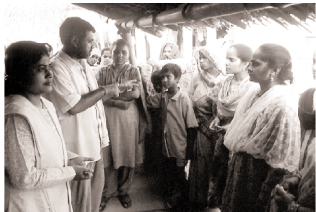Dussehri s entrepreneurs
 a village famous for its delicious mangoes is now also an outstanding example of community participation and local entrepreneurship. Lying off the Lucknow Malihabad road near Kakori, in Uttar Pradesh, the village has had its share of troubles. Deteriorating and diminishing yields had pushed the people into the grip of moneylenders. Every household was in great debt and barely able to make both ends meet.
a village famous for its delicious mangoes is now also an outstanding example of community participation and local entrepreneurship. Lying off the Lucknow Malihabad road near Kakori, in Uttar Pradesh, the village has had its share of troubles. Deteriorating and diminishing yields had pushed the people into the grip of moneylenders. Every household was in great debt and barely able to make both ends meet.
Time for change This situation was destined to change with the coming of Anil K Singh of need (Network of Entrepreneurship & Economic Development). His endeavor was not without its share of troubles. He adopted unconventional methods of singing songs to attract peoples attention. His tenacity paid off and the villagers veered around to his cause and got their first lesson in community strength.
"Initially our aim was to create a rapport and it was only after establishing our credibility that we made attempts to sensitise the people' says Anil. In accordance with need 's main motto of women's empowerment the women of the village were invited to join the deliberations. Latifa a member of the village community says "We were very apprehensive in the beginning fearing betrayal but soon realised Anilji had the common good in mind.'
Women power The women responded to the idea of working together despite caste considerations. The slogan Aadha gaon naari hai, phir bhi kyon bechaari hai gave a new lease to their lives. It literally means that with half the village consisting of women why is there a spirit of helplessness? In the next couple of days the first self help group ( shg ) was formed. The women of similar economic status pooled their resources together and lent money to each other. Anil knew he had tapped a potent force. "A women's instinct of saving money for the rainy day is what we successfully tapped,' he says.
The deposit was increased from Rs 10 to Rs 20 in the Warsi Mahila Samuha formed by Latifa, along with 10 other women. "We give loans for food, housing and even emergencies.' Latifa says. The shg also takes care of village environment and hygiene. Today there are 12 shg s and more than 150 women benefiting from the programme.
shg loans have facilitated improved lifestyles. The children who loitered aimlessly are now going to school. "There are loans for admission fees, schooldresses and even for books' says Bina Srivastava, a member of another shg . Bina's 16-member group pooled its resources to buy five sewing machines. need once again came in handy. They got them an order for making jute bags for the Lucknow tea market. "Although we get Rs 3 per bag we hope to make more money once the acceptance for our bag grows in the market,' says Neetu a young propagator of shg . Enterprise and initiative are the dominant characteristics of these groups manned by women.
The secret of the success lies in complete decentralisation. Anil Singh reiterates "As soon as the groups are self sufficient need will move out and the women will have to fend for themselves. Though, there will be constant monitoring which we feel is a prerequisite to sustaining such an endeavor.' Latifa's Warsi Mahila Samuha a wing of shg occupies itself with embroidery an art that is in great demand all around the world. need helped by teaching the members the finer nuances of the art. Now they earn much more and have started getting orders straight from the market with the elimination of the middlemen.
need has successfully started 22,000 shg s in 1,700 villages across the country. Women have taken control of their lives. Self-assurance and confidence is evident in their very attitude. Today the slogan that drives the women of Dussehri is naari ko bhi kaam chahiye, kaam ka poora daam chahiye, which means women want to work but expect to be paid adequately for the work. The men who were initially critical of the whole idea are now pleased with the additional household income. need has with people's participation created many happy homes.
